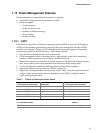
Product Description
29
1.13.1.2 Wake Up Devices and Events
Table 9 lists the devices or specific events that can wake the computer from specific states.
Table 9. Wake Up Devices and Events
These devices/events can wake up the computer… …from this state
Power switch S1, S3, S5
RTC alarm S1, S3, S5
LAN S1, S3
Modem S1, S3
USB S1, S3
PCI bus PME# S3
1.13.1.3 Plug and Play
In addition to power management, ACPI provides controls and information so that the operating
system can facilitate Plug and Play device enumeration and configuration. ACPI is used only to
enumerate and configure devices that do not have other hardware standards for enumeration and
configuration. PCI devices on a desktop board, for example, are not enumerated by ACPI.
1.13.2 Hardware Support
CAUTION
If Wake on network event and Instantly Available technology features are used, the power supply
must be capable of providing adequate +5 V standby current. Failure to provide adequate standby
current can damage the power supply. The total amount of standby current required depends on
the wake devices supported and manufacturing options. Refer to Section 2.11.3 on page 54 for
additional information.
The board provides several hardware features that support power management, including:
• Power connector
• Wake on network event
• Instantly Available technology
• Wake on Ring
• Resume on Ring
Wake on network event and Instantly Available technology require power from the +5 V standby
line. The sections discussing these features describe the incremental standby power requirements
for each.
Wake on Ring and Resume on Ring enable telephony devices to access the computer when it is in
a power-managed state. The method used depends on the type of telephony device (external or
internal) and the power management mode being used (ACPI).
✏
NOTE
The use of Wake on Ring and Resume on Ring technologies from an ACPI state require the support
of an operating system that provides full ACPI functionality.


















